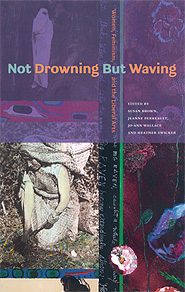Women, Feminism and the Liberal Arts

Susan Brown, Jeanne Perreault, Jo-Ann Wallace & Heather Zwicker, eds. Edmonton, AB: University of Alberta Press, 2011; 472 pp; ISBN: 978-0-88864-550-0, paper $39.95 CAD.
Reviewed by Shannon Dea
I recently took part in my first triathlon. The event begins with the swim and I had heard the other swimmers can be aggressive. But in the water, surrounded by other 40-something women, I found the opposite. When one swimmer bumped into another, she’d often smile and chat for a moment before moving on. In many respects, Not Drowning But Waving parallels this experience — the waters are friendly but crowded, and the crowding lends to confusion.
The anthology features papers based on presentations at a 2006 conference at the University of Alberta in honour of Patricia Clements, U of A’s first female dean of arts. The resulting chapters span a wide range of topics in three broad categories: women in Canadian academe, the wave theory of feminism, and feminist activism in the broader community. Accordingly, the book is divided into sections, each focusing on one of these areas.
The first of these, “Not Drowning,” gathers 10 chapters exploring such topics as feminist institutional history, changing demands on university workers, and work-life balance. Among these, Clements’ memoir, “My World as in My Time,” is gripping and unlikely to leave any university woman unmoved. A clear-eyed chronicle of Clements’ often difficult path from rural Saskatchewan to the dean’s office and her work there to improve equity on campus and to cope with the conservative backlash to her equity work, this chapter should be mandatory reading for Canadian academics.
Other outstanding contributions include Heather Zwicker’s bracingly candid, engagingly written consideration of the causes, phenomenology and unexpected lessons of academic burnout, “Things We Gained in the Fire,” and “Desperately Seeking Equity,” Louise Forsyth’s account of the court challenge of the Canada Research Chairs Program by Forsyth and her seven co-complainants. Cecily Devereux’s “What to Expect When You’re Not Expecting” challenges the view that it is women’s biological destiny to bear children that prevents them from reaching the upper echelons of institutions. Devereux urges that if it is impossible for people raising children to assume all the travel and long hours required to excel in academe, then universities and scholars must change their expectations.
The second section of the book grapples with the “wave” metaphor frequently invoked to capture feminism’s generations. In eight chapters that range from broad theorizing to considerations of such specifics as pedagogical deployments of Wollstonecraft’s A Vindication of the Rights of Woman, this section examines the notion that feminism can or should be historicized in terms of waves.
The real standouts of this section are Heather Murray’s “The Way They Stayed,” which uncovers the fascinating history of the University of Toronto’s United Alumnae Association; Isobel Grundy’s warm, witty and wise “Mentoring,” and Ann Wilson’s “Knitters and Night Cleaners.” In the last of these, Wilson recounts two instances in which she and colleagues unintentionally overlooked less powerful women at the university — graduate students and cleaning staff. As I read this chapter, I recognized my own similar overlooking, and it made me cringe. Many scholars would do well to read it and cringe too.
The final section, “Activism,” gathers four contributions concerned with applying feminist values in the university and in the broader community. This section contains discussions of some of the most important topics in the volume: (counter-) memorializing the victims of violence, the disappeared First Nations women of Vancouver’s Downtown Eastside, and the protracted legal battle (still painfully remembered by many Canadian feminists and trans-folk) over whether women’s shelters ought to employ transsexuals. However, in part because this section is so short, and because there is so little discussion of academe or waves in its chapters, it feels like an afterthought, detached from the rest of the volume.
Indeed, while the volume contains many chapters well worth reading, the editors’ efforts to combine the three main threads are ultimately unsuccessful. I often found myself asking “Why does this chapter belong in this book rather than some other?” Several of the chapters seemed to belong more naturally to another section of the book. Their placement is confusing and highlights the disjunction between the first section and the last two. While the editors were no doubt keen to include as many of the conference papers as possible, the volume would have been more cohesive and readable had it been limited to considerations of women and feminist issues in Canadian academe, which is, in any event, where the editors’ hearts seem to lie.
Given all the bodies in the water, it is furthermore disappointing to see such little disciplinary diversity among the contributors. Nineteen of the 26 contributors are from English departments, despite the fact the volume is explicitly concerned with the liberal arts as a whole. It may well be the editors think English scholars are particularly well placed to discuss the issues raised in this volume. But if this is the case, they should say so and provide some elaboration of that view.
Whatever the book’s organizational weaknesses, easily half the chapters are as good as one could hope to read anywhere. Most Canadian liberal arts scholars will find several chapters here that resonate with them, several that edify them, and a couple that challenge them to do better. This volume should be in the office of every faculty association, senior administrator and equity officer across the country.
---------------------------------------------------------------
Shannon Dea is a philosophy professor at the University of Waterloo.